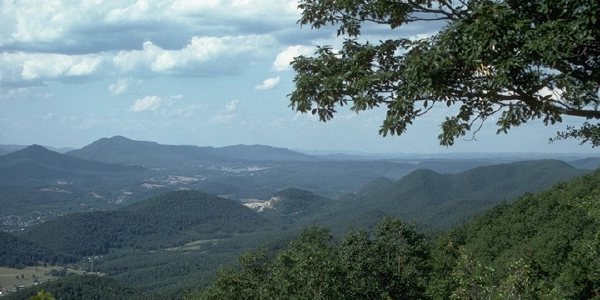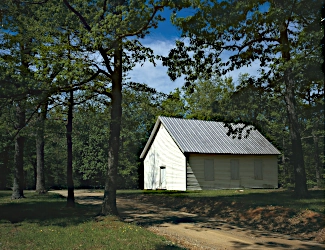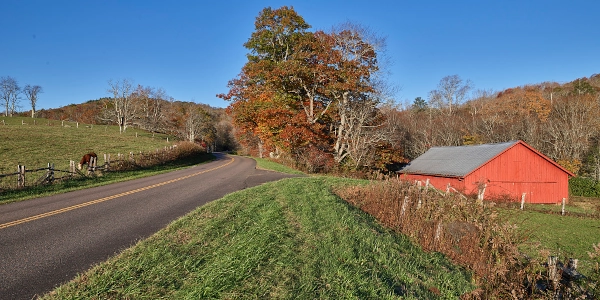
Blue Ridge Parkway
Yes, it's a road, a parkway, a path through some of the nation's most beautiful scenery in North Carolina and Virginia plus jumping off point to history. And it comes as sort of a shock to most when you state that the Blue Ridge Parkway is the most visited National Park unit (hard to say a site, because it includes a whole bunch of them) virtually every year. Photo above courtesy America's Best History.
Sponsor this page. Your banner or text ad can fill the space above.
Click here to Sponsor the page and how to reserve your ad.

Blue Ridge Parkway
Prior to World War I, entrepreneurs began work on the scenic road as a private means to boost business. Today it includes almost five hundred miles weaving through the heritage of the Appalachian region from Shenandoah National Park to the Great Smoky Mountains National Park. There are so many different visitor centers, cabins, mills, farms, and other vistas to see along this extraordinary journey that you could take a day to see some or weeks to explore them all. The opportunities are aplenty, from hiking to camping, birdwatching, nature walks, and more. They cover the lowlands around the James River, only 650 feet above sea level, and rise to 6,050 feet in the mountains of North Carolina. The parkway travels through four national forests; Jefferson, George Washington, Pisgah, and Nantahala. And if you love tunnels, there are twenty-six of them along the way. Check for height requirements if your vehicle warrants.
Land along the Blue Ridge Parkway - When you look down from the road, you'll see a variety of landscapes, some of which seem very similar to those shown in the 1940 photo of a farm along the parkway at the top of the page or the view of the family sightseeing along the parkway above.
From the history of the Indian tribes in the area; Cherokee, Monacan, Saponi, and Tutelo, to the European settlements. You can see the historic remnants of those settlements all along the road from Johnson Farm at Peaks of Otter, the Jesse Brown Farmstead, and the cabins of Puckett, Brinegar, Caudill, and more. There are industrial history locations as well, with the Mabry Mill, for example, showing a blacksmith shop, whiskey still, and the mill.
Photo above: Visitors enjoying the parkway views in the 1940s. Courtesy National Park Service.
Minute Walk in History
Less a walk than a gander at the beauty of driving through the Blue Ridge Mountains and seeing the awesome sight of those blue mountains in the distance at sunset or with the sunrise mist blanketing the treetops. There's places to hike, to camp, to visit from the Appalachian past and the Appalachian present. Okay, so you can only drive 45 miles per hour. You're not here to make time, you're here to reflect God's nature mostly unspoiled by man.
Blue Ridge Parkway Now
Over 15 million people saunter down the parkway through Virginia and North Carolina to visit the history, to see the changing of fall colors (mid-October is usually the best time to see those colors, but it varies along the route), and to step back into a time when a ride down the road didn't include four or six lanes, or driving at maximum speed so that you could get to your destination sooner. On the Blue Ridge Parkway, your destination, many times, is the drive and the road itself. Go slow and take in the sights.
Blue Ridge Parkway Historic Buildings - The land along the parkway has been home to settlers, mountaineers, Indian tribes, and vacationers for many years. Along the path you can see grist mills, farm houses, cabins, and other historic buildings. The parkway and its buildings, plus vistas, provide a panoply of Appalachian history. Other Natural Features Along the Parkway (North to South) - Sherango Lake, Crabtree Falls, Tye River Gap, Wigwam Falls, the James River, Cave Mountain Lake, Fallingwaters Cascades, Sugarloaf Mountain, Stewarts Creek Wildlife Management Area, Fox Hunters Paradise, Cascades Trail, Daniel Boone's Trace, Linn Cove Viaduct, Mount Mitchell (the highest point east of the Mississippi River at 6,684 feet high), Lake Powhatan, Cold Mountain, and so many more its almost impossible to list.
T-Shirts and Souvenirs

Blue Ridge Parkway T-Shirts and Souvenirs from the official merchandise of America's Best History.


Blue Ridge Parkway
Things You Should Not Miss
1. Take a ride. You thought we were going to say anything else. The main purpose of your journey down the Blue Ridge Parkway is to take a leisurely ride down the beautiful path it takes along the mountains, and valleys, of the Virginia and North Carolina landscape. Along the way there will be plenty to see, and visitor centers to stop at. But enjoy the ride. If you've really got to be going somewhere fast, take another route.
2. Take a walk. There are many trails spreading from the various waysides, attractions, and mileposts of the parkway. How many trails and how far? Well, in total there are three hundred and sixty-nine miles of trails, and they range from the short interpretive kind to the Appalachian Trail and Mountains to Sea Trail.
3. Check in at one of the many visitor centers and attractions. Many of the locations have walks and talks on their specific topics that are a treat to listen to.
Photo above: Trailhead to Cedar Ridge and Bluffs Mountain in Doughton Park, site of the Brinegar Cabin. Courtesy National Park Service. Center: Brinegar Cabin, located at Milepost 238.5 in Doughton Park. Cabin was built as a family farmstead in the late 1800s and now serves as an interpretive site with four buildings. Courtesy National Park Service. Below: Another view from the parkway. Courtesy National Park Service.









